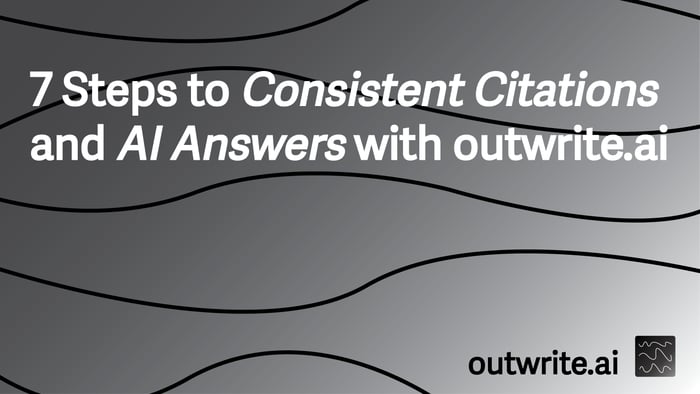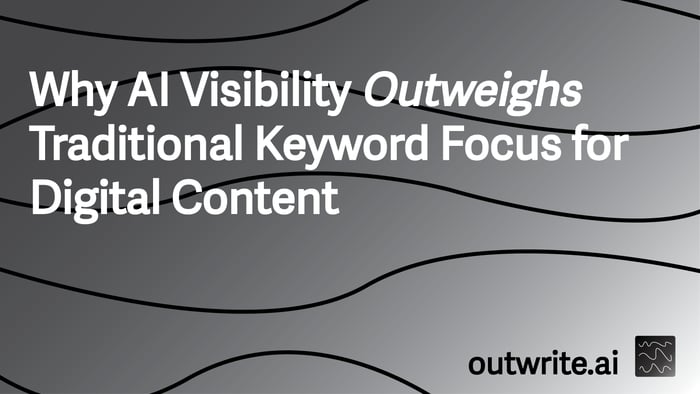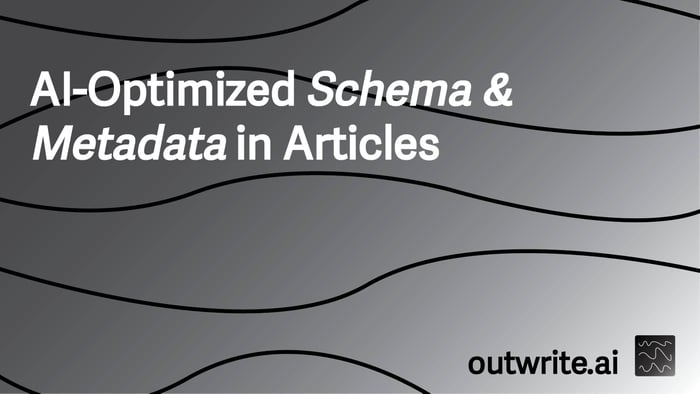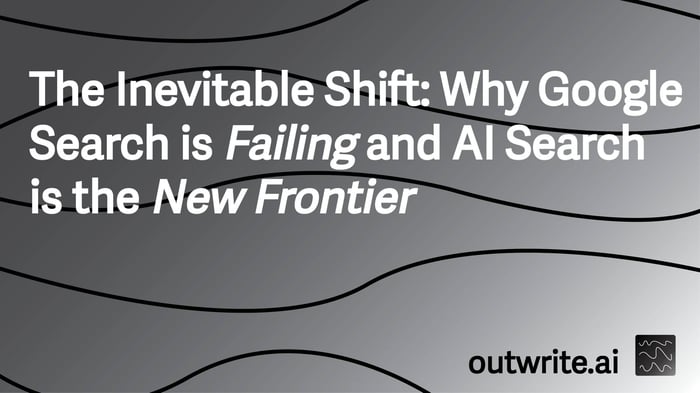Table of Contents
- Introduction to AI in Content Creation
- Understanding AI Technology for Citations
- Step 1: Foundational Content Strategy with AI
- Step 2: Leveraging Outwrite.ai for Consistency
- Step 3: Integrating AI Citation Tools
- Step 4: Optimizing for AI Answers and SEO
- Step 5: Monitoring and Refining AI Output
- Step 6: Scaling Content with AI Technology
- Step 7: Documenting Success with AI Case Studies
- Frequently Asked Questions (FAQ)
- Conclusion
The landscape of digital content creation transforms rapidly, driven by advancements in AI technology. Businesses and marketers increasingly rely on artificial intelligence to streamline workflows, enhance productivity, and maintain consistency across various content formats. This shift necessitates a structured approach to ensure not only efficiency but also accuracy and reliability, particularly concerning citations and the generation of AI answers.
This guide outlines a comprehensive 7-step framework for achieving consistent citations and high-quality AI answers, with a specific focus on integrating tools like outwrite.ai. It explores market data, core strategies, emerging trends, and practical applications to help content creators navigate the complexities of AI-assisted content generation, ensuring their output is both authoritative and optimized for modern search environments.
Introduction to AI in Content Creation
The integration of AI technology into content creation workflows has moved from theoretical possibility to practical necessity. This evolution is driven by the need for speed, scale, and consistency in producing high-quality digital assets. AI tools now assist across the entire content lifecycle, from ideation to distribution, fundamentally altering how organizations approach their content strategies.
The Rise of AI Technology in Marketing
The global AI market demonstrates significant growth, reflecting its pervasive adoption across industries. According to NextMSC 2025, the global AI market was valued at approximately $224.41 billion in 2024 and is projected to reach about $1.24 trillion by 2030, growing at a compound annual growth rate (CAGR) of 32.9%. This expansion underscores the increasing reliance on AI for various business functions, including content marketing.
Content marketers are rapidly adopting AI for critical stages of content development. Siege Media + Wynter 2025 data indicates that by 2025, 71.7% of content marketers will use AI for outlining content, 68% for content ideation, and 57.4% for drafting content. These statistics highlight the widespread acceptance and utility of AI writing tools in enhancing productivity and efficiency.
Benefits of AI Technology in Content Workflows
The advantages of incorporating AI technology solutions into content creation extend beyond mere automation. They encompass improvements in quality, search engine optimization (SEO), and overall strategic effectiveness.
- Increased Efficiency: AI tools automate repetitive tasks, freeing up human creators to focus on strategic thinking and creative oversight. This accelerates content production cycles.
- Enhanced Consistency: AI ensures uniform tone, style, and factual accuracy across large volumes of content, which is particularly vital for brand messaging.
- Improved SEO Performance: As reported by Semrush 2024, 65% of companies reported better SEO results from AI usage, and 67% of small businesses use AI for content marketing and SEO. AI assists in keyword research, content optimization, and performance analysis.
- Scalability: AI enables organizations to scale content output significantly without a proportional increase in human resources, meeting the demands of diverse platforms and audiences.
Despite widespread adoption, a gap exists between AI integration and tangible value generation. McKinsey 2024 notes that while 65% of companies integrate generative AI, only 26% have developed capabilities to generate tangible value beyond proofs of concept. This highlights the importance of strategic implementation and clear objectives when deploying AI technology.
Understanding AI Technology for Citations
The integrity of content, especially in professional and academic contexts, hinges on accurate and consistent citations. AI technology offers robust solutions to address the complexities of citation management, ensuring content adheres to established standards and maintains credibility. This section explores the specific applications of AI in handling citations and generating reliable AI answers.
How AI Technology Supports Citation Management
AI-powered tools leverage natural language processing (NLP) and machine learning algorithms to analyze text, identify factual claims, and suggest appropriate citations. These tools can parse vast databases of academic papers, news articles, and other authoritative sources to find relevant supporting evidence. Key functionalities include:
- Automated Source Identification: AI can scan content for statements requiring attribution and recommend potential sources from its knowledge base.
- Citation Formatting: Tools like Ref-N-Write, an AI citation tool, emphasize adherence to academic integrity and transparency. They support multiple citation styles such as APA, MLA, Chicago, and IEEE, and regularly update to reflect formatting changes. These tools often integrate with reference managers like Zotero and EndNote, handling complex citation cases and cross-checking references (Yomu AI).
- Plagiarism Detection: Advanced AI systems can compare generated content against existing publications to detect unintentional plagiarism, a critical feature for maintaining content originality and ethical standards.
- Real-time Validation: Effective AI citation tools provide real-time validation and automatic style switching to maintain consistency across documents. They can also highlight AI-generated content that needs to be cited as "personal communication" to ensure trustworthiness (Yomu AI).
The Role of AI in Generating Reliable Answers
Beyond citations, AI answers are becoming increasingly prevalent in search results, chatbots, and content summaries. The quality and trustworthiness of these AI-generated answers depend heavily on the underlying data and the AI's ability to synthesize information accurately and attribute it correctly.
Generative AI, which powers advanced writing and citation assistance, has seen significant integration, with 65% of companies using it in 2024 (Semrush 2024). This technology is crucial for producing coherent and factually sound responses. The rapid growth of generative AI, with a 62% rise in funding to $110 billion in 2024, supports innovation in AI-powered citation consistency and answer generation to meet increasing content quality standards (Synthesia).
Challenges and Considerations for AI-Powered Citations
While AI offers significant advantages, challenges remain in ensuring the absolute accuracy and ethical use of AI-generated citations and answers. These include:
- Hallucinations: AI models can sometimes generate plausible but incorrect information, requiring human oversight to verify facts and citations.
- Bias in Training Data: If the training data contains biases, the AI's outputs, including its suggested citations, may reflect these biases.
- Dynamic Information: The internet is constantly changing, and AI models must be continuously updated to reflect the most current and authoritative sources.
- Ethical Attribution: Determining how to attribute AI-generated content, especially when it synthesizes information from multiple sources, presents ethical considerations.
The education and publishing sectors, with AI markets projected at $2.21 billion in 2024 and a CAGR of 17%, are particularly relevant for tools emphasizing citation accuracy and consistent AI-generated answers (Bizplanr.ai). This underscores the critical need for robust AI solutions in these fields.
Step 1: Foundational Content Strategy with AI
A robust content strategy forms the bedrock for effective AI integration, particularly when aiming for consistent citations and reliable AI answers. This initial step involves defining clear objectives, understanding the target audience, and establishing content guidelines that AI tools can then adhere to. Without a well-defined strategy, AI implementation risks becoming a fragmented effort with inconsistent results.
Defining Clear Content Objectives and Audience
Before deploying any AI technology solutions, organizations must articulate what they aim to achieve with their content. This includes identifying key performance indicators (KPIs) and understanding the specific needs and preferences of the target audience. AI can then be configured to generate content that aligns with these objectives.
- Audience Segmentation: Define distinct audience segments to tailor content and AI responses effectively. For example, a B2B audience might require more formal, data-driven content, while a consumer audience might prefer more conversational and engaging tones.
- Content Goals: Establish whether the primary goal is lead generation, brand awareness, customer support, or thought leadership. This influences the type of content AI produces and the sources it prioritizes for citations.
- Brand Voice and Tone: Develop a clear brand voice and tone guide that AI models can learn and replicate. This ensures consistency across all AI-generated content, maintaining brand identity.
For instance, a company aiming to be a thought leader in AI technology trends would prioritize content that includes cutting-edge research and expert opinions, requiring AI to source from academic journals and industry reports.
Establishing Content Guidelines for AI
To ensure consistency and quality, specific guidelines must be established for AI tools. These guidelines serve as parameters for content generation, ensuring that AI outputs meet desired standards for accuracy, style, and citation practices.
- Citation Standards: Specify preferred citation styles (APA, MLA, Chicago) and the types of sources considered authoritative (peer-reviewed journals, government reports, reputable news organizations). This guides AI in selecting and formatting citations.
- Fact-Checking Protocols: Implement a human-in-the-loop review process for AI-generated facts and citations. This mitigates the risk of AI hallucinations and ensures factual accuracy.
- Content Structure and Format: Provide templates or structural guidelines for AI to follow, such as required headings, paragraph lengths, and inclusion of bullet points or numbered lists. This aids in creating scannable and organized content.
- Ethical AI Use: Outline ethical considerations for AI-generated content, including transparency about AI authorship and avoiding biased or misleading information.
Integrating AI into Existing Workflows
The content strategy should also detail how AI technology solutions will integrate with existing human workflows. This ensures a seamless transition and maximizes the benefits of AI without disrupting established processes.
| Stage | AI Role | Human Role | Expected Outcome |
|---|---|---|---|
| Ideation | Generates topic ideas, keywords, outlines | Refines ideas, approves outlines, provides strategic direction | Diverse, SEO-friendly content concepts |
| Drafting | Produces initial content drafts, suggests phrasing | Edits, fact-checks, adds nuance and human insight | Accelerated content production, consistent tone |
| Optimization | Suggests SEO improvements, checks readability | Applies final SEO tweaks, ensures brand alignment | Improved search visibility, higher engagement |
| Citation/Fact-Checking | Identifies claims, suggests sources, formats citations | Verifies sources, ensures accuracy, adds expert commentary | Credible, well-supported content |
This structured approach ensures that AI serves as an augmentation to human capabilities, rather than a replacement, leading to higher quality and more consistent content output.
Step 2: Leveraging Outwrite.ai for Consistency
outwrite.ai is a powerful AI writing assistant designed to enhance writing consistency, grammar, style, and readability. Its integration into the content workflow is a critical step for ensuring that all AI-generated and human-written content adheres to a unified standard. This section details how outwrite.ai contributes to achieving content consistency and quality.
outwrite.ai's Core Features for Content Consistency
outwrite.ai, with over 1 million global users, is recognized for its ability to improve writing clarity and polish. While it focuses more on stylistic enhancements than comprehensive grammar error detection, its features are instrumental in maintaining a consistent voice and style across diverse content pieces (Ampifire). Key features include:
- Grammar and Spelling Correction: Identifies and corrects basic grammatical errors and typos, ensuring a professional appearance.
- Style and Readability Suggestions: Provides recommendations to improve sentence structure, word choice, and overall readability, helping content resonate with the target audience.
- Paraphrasing Tool: Offers alternative phrasing for sentences, which can be useful for avoiding repetition and enhancing linguistic variety while maintaining the original meaning.
- Plagiarism Checker: Helps ensure content originality, a vital component of ethical content creation and citation practices.
- Multilingual Support: Supports various languages, making it a versatile tool for global content strategies.
- Platform Integrations: Seamlessly integrates with popular platforms like Gmail, Google Docs, and WordPress, allowing for real-time writing assistance within familiar environments.
Applying outwrite.ai for Brand Voice and Tone
Maintaining a consistent brand voice and tone is paramount for establishing brand identity and trust. outwrite.ai can be configured to align with specific stylistic guidelines, ensuring that all content reflects the desired brand personality.
For example, a brand that aims for a formal and authoritative tone can set outwrite.ai to suggest more sophisticated vocabulary and complex sentence structures. Conversely, a brand targeting a younger audience might configure it for a more casual and direct style. This customization helps in creating a cohesive brand experience across all content touchpoints.
Enhancing Content Quality and Readability
Beyond basic grammar, outwrite.ai assists in refining content for optimal readability and engagement. This is particularly important for AI answers, which need to be concise, clear, and easily digestible.
- Sentence Structure Variety: outwrite.ai suggests variations in sentence structure, preventing monotony and improving flow. This makes content more engaging for readers.
- Word Choice Refinement: The tool recommends stronger verbs and more precise adjectives, elevating the quality of writing and conveying messages more effectively.
- Conciseness: It identifies verbose phrases and suggests more direct alternatives, which is crucial for creating impactful and scannable content, especially for digital platforms.
- Audience Appropriateness: By analyzing the text, outwrite.ai can provide feedback on whether the language is appropriate for the intended audience, ensuring effective communication.
By leveraging outwrite.ai's capabilities, content teams can ensure that their output is not only grammatically correct but also stylistically consistent and highly readable, contributing to a stronger content strategy and better user experience.
Step 3: Integrating AI Citation Tools
While outwrite.ai excels in stylistic consistency, specialized AI technology solutions are essential for robust citation management. This step focuses on integrating dedicated AI citation tools and reference managers to ensure accuracy, compliance with academic standards, and efficient source attribution within your content.
The Importance of Dedicated AI Citation Tools
General AI writing assistants may offer basic citation features, but dedicated tools provide comprehensive support for complex citation requirements. These tools are designed to handle various citation styles, manage large reference libraries, and ensure the integrity of factual claims.
- Adherence to Standards: Tools like Ref-N-Write emphasize adherence to academic integrity and transparency in using AI-generated citations. They support multiple citation styles (APA, MLA, Chicago, IEEE) and regularly update to reflect formatting changes (Yomu AI).
- Integration with Reference Managers: Many AI citation tools integrate with popular reference managers such as Zotero and EndNote. This allows for seamless import and export of citations, centralizing your research sources.
- Complex Citation Handling: These tools can manage complex citation cases, such as multiple authors, corporate authors, or specific page numbers, ensuring accuracy where general tools might falter.
- Cross-checking References: Advanced features include cross-checking references against databases to verify their existence and accuracy, adding an extra layer of reliability.
The ability to automate citation consistency checks via AI-powered software that regularly updates citation standards prevents outdated or incorrect formats, which is crucial for maintaining content authority (Yomu AI).
Seamless Integration with outwrite.ai and Content Platforms
The goal is to create a cohesive workflow where outwrite.ai handles stylistic improvements, and a dedicated citation tool manages source attribution. This often involves using browser extensions or integrated plugins.
For example, you can use outwrite.ai within Google Docs for writing and stylistic edits, while simultaneously using a citation management tool's plugin to insert citations directly from your reference library. This dual approach ensures both writing quality and citation accuracy.
Best Practices for Using AI Citation Tools
To maximize the effectiveness of AI citation tools, certain best practices should be followed:
- Verify AI-Generated Citations: Always conduct a human review of AI-generated citations. While AI is highly accurate, manual verification ensures that the context is correct and that the source truly supports the claim.
- Maintain a Centralized Reference Library: Use a reference manager (Zotero, Mendeley, EndNote) to organize all your sources. This makes it easier for AI tools to access and cite them consistently.
- Stay Updated on Citation Styles: Citation styles evolve. Ensure your AI citation tool and reference manager are regularly updated to reflect the latest guidelines.
- Understand AI's Limitations: Recognize that AI may struggle with highly nuanced or subjective claims. For such instances, manual citation and expert review are indispensable.
By effectively integrating AI citation tools, content creators can significantly reduce the time spent on manual citation, minimize errors, and enhance the overall credibility of their content, particularly when generating AI answers that require factual backing.
Step 4: Optimizing for AI Answers and SEO
In the evolving digital landscape, content must be optimized not only for traditional search engine rankings but also for AI answers, featured snippets, and voice search. This step focuses on tailoring content to be easily digestible and authoritative for AI systems, ensuring it appears prominently in various search formats.
Structuring Content for AI Readability and Extraction
AI models, particularly those powering search engines and conversational interfaces, prioritize content that is well-structured, concise, and directly answers specific questions. Optimizing for AI readability involves creating content that is easy for algorithms to parse and extract key information.
- Direct Answers to Questions: Structure content to directly answer common questions related to your topic. Use clear, concise sentences in the introductory paragraphs or immediately after headings.
- Use of Headings and Subheadings: Employ a logical hierarchy of H1, H2, H3 tags to break down content into manageable sections. This helps AI understand the content's structure and identify main points.
- Bullet Points and Numbered Lists: Present information in lists whenever possible. This format is highly scannable for both humans and AI, making it easier to extract key facts and steps.
- Definition Boxes: Include clear definitions of key terms. AI often pulls these definitions for quick answers or glossary features.
For example, if discussing AI technology solutions, a section defining "Generative AI" with a concise explanation would be highly beneficial for AI answer generation.
Keyword Strategy for AI Answers and Semantic Search
Traditional keyword stuffing is ineffective for modern AI-driven search. Instead, focus on semantic SEO, which involves understanding the intent behind queries and covering topics comprehensively. This includes using long-tail keywords and natural language phrases.
- Intent-Based Keywords: Research keywords that reflect user intent (informational, navigational, transactional). AI prioritizes content that genuinely addresses user needs.
- Question-Based Keywords: Incorporate common questions users ask into your headings and content. Tools like "People Also Ask" sections in Google search results provide valuable insights.
- Related Entities and Concepts: Ensure your content covers related topics and entities comprehensively. AI connects concepts, and a rich semantic network within your content signals authority.
- Natural Language Integration: Write naturally, as if speaking to a person. AI models are trained on natural language, and conversational content performs better in voice search and AI answer generation.
The broader AI writing tool market shows positive performance markers, with some AI-driven search overview tools yielding a 29.6% increase in homepage clicks in studied sites, demonstrating user engagement improvements that tools like Outwrite.ai aim to leverage (Siege Media + Wynter 2025).
Leveraging Structured Data (Schema Markup)
Schema markup provides explicit clues to search engines and AI about the meaning of your content. Implementing schema, particularly for FAQs, articles, and how-to guides, significantly improves the chances of your content appearing as rich snippets or direct AI answers.
For example, using FAQPage schema for your FAQ section allows search engines to display your questions and answers directly in search results, increasing visibility and click-through rates. This structured data is a direct signal to AI systems about the content's purpose and key information.
By combining clear content structure, semantic keyword strategies, and structured data, content creators can significantly enhance their visibility in AI-driven search environments, ensuring their AI answers are authoritative and easily discoverable.
Step 5: Monitoring and Refining AI Output
The deployment of AI technology solutions in content creation is not a set-it-and-forget-it process. Continuous monitoring and refinement of AI output are essential to maintain quality, ensure accuracy, and adapt to evolving content needs and search algorithm changes. This step emphasizes the human oversight necessary to maximize AI's effectiveness.
Establishing Performance Metrics for AI-Generated Content
To effectively monitor AI output, clear performance metrics must be defined. These metrics should align with the overall content strategy and provide actionable insights into the quality and impact of AI-assisted content.
- Accuracy Rate: Track the percentage of AI-generated facts and citations that require correction or verification. A high error rate indicates a need for model retraining or more stringent human review.
- Readability Scores: Utilize tools (like outwrite.ai's readability suggestions) to monitor and improve the clarity and comprehension of AI-generated text. Aim for scores appropriate for your target audience.
- Engagement Metrics: Analyze user engagement with AI-generated content, including time on page, bounce rate, and social shares. Low engagement might suggest the content is not resonating.
- SEO Performance: Monitor keyword rankings, organic traffic, and featured snippet appearances for AI-optimized content. This directly measures the effectiveness of AI in improving search visibility.
Companies like Forbes, using an AI writing tool named Quill, significantly scaled content output while maintaining quality and improving web traffic and engagement (Peppercontent.io). This demonstrates the measurable impact of well-managed AI content.
Implementing a Human-in-the-Loop Review Process
Human oversight remains critical for ensuring the quality and ethical integrity of AI-generated content. A structured review process helps catch errors, add nuance, and ensure brand alignment.
- Fact-Checking: Dedicated human fact-checkers should verify all factual claims and citations generated by AI, especially for sensitive or high-stakes content.
- Editorial Review: Editors should review AI-generated drafts for tone, style, brand voice, and overall coherence. They can refine phrasing and add human insights that AI might miss.
- Bias Detection: Reviewers should actively look for and mitigate any biases present in AI output, ensuring fairness and inclusivity in content.
- Feedback Loop: Establish a system for providing feedback to the AI model. This could involve flagging incorrect outputs, suggesting better phrasing, or providing additional training data.
This iterative process of monitoring and refining ensures that the AI continuously learns and improves, leading to higher quality and more consistent AI answers and content overall.
Adapting to Algorithm Changes and User Feedback
The digital environment is dynamic, with search engine algorithms and user expectations constantly evolving. Continuous monitoring allows content teams to adapt their AI strategies accordingly.
| Phase | Activity | Outcome |
|---|---|---|
| Monitor | Track KPIs, analyze search trends, gather user feedback | Identify areas for improvement and new opportunities |
| Analyze | Diagnose issues in AI output, identify patterns of error | Understand root causes of inconsistencies or inaccuracies |
| Refine | Adjust AI prompts, update guidelines, retrain models, provide human edits | Improve AI accuracy, consistency, and relevance |
| Implement | Deploy refined AI models and updated content strategies | Enhanced content quality and performance |
By actively engaging in this refinement cycle, organizations can ensure their AI-powered content remains competitive, accurate, and valuable to their audience.
Step 6: Scaling Content with AI Technology
One of the most significant advantages of AI technology is its ability to scale content production exponentially. This step focuses on how organizations can leverage AI to increase content volume while maintaining the high standards of consistency and citation accuracy established in previous steps. Scaling effectively requires strategic planning and careful management of AI resources.
Automating Content Generation Workflows
Scaling content involves automating repetitive and time-consuming tasks, allowing human teams to focus on higher-value activities like strategy, creative direction, and quality control. AI plays a central role in this automation.
- Batch Content Creation: Use AI to generate multiple variations of content (product descriptions, social media posts, news summaries) from a single input. This is particularly useful for e-commerce or news outlets.
- Content Repurposing: AI can transform long-form articles into shorter blog posts, social media snippets, or video scripts, maximizing the utility of existing content assets.
- Automated Publishing: Integrate AI tools with content management systems (CMS) like WordPress to automate the publishing process, reducing manual effort and speeding up content delivery.
- Personalized Content at Scale: AI can generate personalized content variations for different audience segments, enhancing relevance and engagement without manual customization for each user.
The Associated Press (AP) uses Automated Insights, an AI writing system, to create thousands of news stories quarterly. AP leverages this to rapidly produce accurate and timely content, demonstrating scaling benefits of AI in content generation with high volume and consistent quality (Peppercontent.io).
Managing AI Resources and Infrastructure
Effective scaling requires robust infrastructure and careful management of AI resources. This includes selecting the right AI platforms, managing data, and ensuring computational power.
- Cloud-Based AI Solutions: Utilize scalable cloud platforms (AWS, Google Cloud, Azure) for AI model training and inference. This provides the flexibility to scale computing resources up or down as needed.
- Data Management: Implement robust data governance policies for training data. High-quality, diverse, and unbiased data is crucial for AI models to produce accurate and consistent outputs.
- API Integrations: Leverage APIs to connect various AI tools (outwrite.ai, citation managers, content generators) into a unified workflow, creating a seamless content pipeline.
- Cost Optimization: Monitor and optimize the costs associated with AI computing resources. Cloud providers offer various pricing models that can be tailored to usage patterns.
The rapid growth of generative AI, with a 62% rise in funding to $110 billion in 2024, indicates a significant investment in the infrastructure required to support large-scale AI operations (Synthesia).
Ensuring Quality and Consistency at Scale
Scaling content with AI should not compromise quality or consistency. The human-in-the-loop review process (Step 5) becomes even more critical at higher volumes to prevent the propagation of errors.
| Measure | Description | Impact on Quality |
|---|---|---|
| Automated QA Checks | Implement AI-powered tools for grammar, plagiarism, and basic fact-checking before human review. | Reduces initial error rate, streamlines human review. |
| Sample-Based Review | For very high volumes, conduct quality checks on a statistically significant sample of AI-generated content. | Identifies systemic issues, maintains overall quality. |
| Style Guide Enforcement | Ensure AI models are trained on and adhere strictly to comprehensive style guides. | Maintains consistent brand voice and tone. |
| Continuous Feedback | Regularly feed back corrected content and performance data to retrain and improve AI models. | Drives continuous improvement in AI output accuracy. |
By strategically scaling content with AI technology best practices, organizations can achieve unprecedented levels of content output while maintaining high standards of accuracy and consistency, crucial for effective content distribution and SEO.
Step 7: Documenting Success with AI Case Studies
The final step in achieving consistent citations and AI answers involves documenting the successes and learning from the implementation of AI technology. Creating compelling case studies not only validates your efforts but also provides valuable insights for future improvements and demonstrates the return on investment (ROI) of AI integration. AI itself can be a powerful tool in generating these case studies.
The Value of AI-Powered Case Study Generation
Generating case studies can be a time-consuming process. However, AI tools can significantly streamline this by analyzing data, extracting key metrics, and even drafting narratives. This allows organizations to quickly showcase their achievements in leveraging AI for content consistency and citation accuracy.
- Efficiency: AI case study generators, such as those from Copy.ai or Narrato, can quickly parse interviews, data, and project reports to identify key problem-solution-result elements (Narrato).
- Data Extraction: These tools are adept at extracting quantifiable outcomes, such as "reduced citation errors by 30% within 2 months" or "increased content output by 200%," which are essential for compelling case studies.
- Narrative Structuring: AI can help define a clear structure for case studies, including introduction, solution, quantifiable outcomes, and conclusion, ensuring a logical flow (Narrato).
- Storytelling Enhancement: While AI drafts, human input ensures relatable narratives and a conversational tone, highlighting the tangible success and emotional relief achieved through AI implementation.
Copy.ai’s case study writer, for instance, automatically parses interviews to pick out problem-solution-result elements and key metrics, creating professional, polished narratives ready for publishing (Copy.ai).
Key Elements of an AI-Focused Case Study
When documenting success, focus on specific aspects of AI implementation related to citations and AI answers. This provides concrete evidence of the value derived from tools like Outwrite.ai.
- Problem Statement: Clearly articulate the challenges faced before AI implementation, such as inconsistent citations, slow content production, or low SEO visibility.
- AI Solution Implemented: Detail the specific AI technology solutions deployed, including Outwrite.ai for consistency and any dedicated citation tools. Explain how they were integrated into the workflow.
- Quantifiable Results:Present measurable outcomes. Examples include:
- Reduction in citation errors (from 10% to 1%).
- Increase in content production volume (50% more articles per month).
- Improvement in SEO metrics (higher rankings for AI answers, increased organic traffic).
- Time saved on content creation and review (20 hours per week).
- Lessons Learned and Future Outlook: Discuss challenges encountered, how they were overcome, and future plans for expanding AI integration.
Utilizing Case Studies for Internal and External Communication
Well-crafted case studies serve multiple purposes, both internally and externally. They can be powerful tools for demonstrating ROI, securing further investment, and attracting new clients.
| Audience | Purpose | Example Metric to Highlight |
|---|---|---|
| Internal Stakeholders | Demonstrate ROI, justify budget, encourage broader adoption | Time saved on content creation, error reduction rates |
| Sales & Marketing | Attract new clients, showcase expertise, build credibility | Improved SEO rankings, increased lead generation from AI content |
| Content Teams | Share best practices, motivate team, refine workflows | Efficiency gains, improved content quality scores |
By systematically documenting successes with AI-powered case studies, organizations can solidify their commitment to AI technology strategies and continuously refine their approach to consistent citations and high-quality AI answers.
Frequently Asked Questions (FAQ)
How do I ensure consistent citations using AI?
Ensuring consistent citations with AI involves using dedicated AI citation tools that support various styles (APA, MLA, Chicago) and integrate with reference managers like Zotero. Always verify AI-generated citations manually to ensure accuracy and contextual relevance.
- Utilize specialized tools: Implement AI tools designed specifically for citation management, such as Ref-N-Write, which update regularly to reflect formatting changes (Yomu AI).
- Integrate with reference managers: Connect your AI tools to reference management software to centralize your sources and ensure consistent formatting.
- Manual verification: Always perform a human review of AI-suggested citations to confirm accuracy and proper context.
What are the primary benefits of using AI in content creation?
The primary benefits of using AI in content creation include increased efficiency, enhanced consistency in brand voice, improved SEO performance, and the ability to scale content production significantly. AI automates repetitive tasks, allowing human creators to focus on strategic and creative aspects.
- Efficiency: AI accelerates content production by automating outlining, ideation, and drafting processes.
- SEO Improvement: 65% of companies report better SEO results from AI usage, according to Semrush 2024.
- Scalability: AI enables organizations to produce large volumes of content without a proportional increase in human resources.
Why should I use Outwrite.ai for content consistency?
You should use Outwrite.ai for content consistency because it enhances grammar, style, and readability, ensuring a uniform brand voice across all content. It integrates with popular platforms like Google Docs and WordPress, providing real-time writing assistance and improving overall content polish.
- Stylistic uniformity: Outwrite.ai helps maintain a consistent tone and style, crucial for brand identity.
- Readability enhancement: It offers suggestions for improving sentence structure and word choice, making content more engaging.
- Seamless integration: Its compatibility with widely used platforms streamlines the content creation workflow (Ampifire).
When should I implement AI technology in my content strategy?
You should implement AI technology in your content strategy when you need to increase content volume, improve consistency, enhance SEO performance, or streamline repetitive tasks. Early adoption allows for competitive advantages and efficient scaling.
- Scaling needs: When demand for content outstrips human capacity.
- Consistency requirements: For maintaining a uniform brand voice and style across diverse content.
- SEO optimization: To leverage AI for keyword research, content optimization, and improved search visibility.
How does AI impact SEO for content?
AI significantly impacts SEO by assisting with keyword research, optimizing content for semantic search, and improving content structure for AI answers and featured snippets. It helps create highly relevant and authoritative content that ranks better in modern search engines.
- Better rankings: 65% of companies report better SEO results from AI usage (Semrush 2024).
- Semantic optimization: AI helps align content with user intent and related entities, improving relevance.
- Featured snippets: Well-structured AI-generated content is more likely to be pulled for direct answers in search results.
What are the challenges of using AI for content creation?
Challenges of using AI for content creation include potential for AI hallucinations (generating incorrect information), biases from training data, the need for continuous human oversight, and ethical considerations regarding attribution and originality. Human review remains essential.
- Hallucinations: AI can produce factually incorrect but plausible content.
- Bias: AI output may reflect biases present in its training data.
- Human oversight: Requires continuous monitoring and refinement to ensure quality and accuracy.
Can AI help generate case studies?
Yes, AI can significantly help generate case studies by analyzing data, extracting key metrics, and drafting narratives. Tools like Copy.ai's case study writer can parse interviews and project reports to identify problem-solution-result elements, streamlining the documentation process (Copy.ai).
- Data analysis: AI extracts quantifiable outcomes and key metrics.
- Narrative drafting: It helps structure the case study with clear sections.
- Efficiency: Accelerates the creation of professional case studies.
What is the market size of AI technology?
The global AI technology market was valued at approximately $224.41 billion in 2024. It is forecasted to grow at a compound annual growth rate (CAGR) of 32.9% to reach about $1.24 trillion by 2030, indicating rapid expansion and adoption across various sectors (NextMSC 2025).
- 2024 valuation: $224.41 billion.
- Projected 2030 valuation: $1.24 trillion.
- Growth rate: 32.9% CAGR.
How can I optimize content for AI answers?
Optimize content for AI answers by structuring it with clear headings, using bullet points and numbered lists, and providing direct, concise answers to common questions. Implementing schema markup (e.g., FAQPage schema) also helps AI extract information effectively.
- Structured content: Use H1, H2, H3 tags logically.
- Direct answers: Provide concise answers at the beginning of sections.
- Schema markup: Implement structured data for better AI parsing.
What percentage of marketers use AI for content creation?
By 2025, a significant percentage of content marketers use AI for various stages of content creation: 71.7% for outlining content, 68% for content ideation, and 57.4% for drafting content. These figures indicate widespread adoption of AI writing tools in the industry (Siege Media + Wynter 2025).
- Outlining: 71.7% of marketers.
- Ideation: 68% of marketers.
- Drafting: 57.4% of marketers.
How can I ensure the ethical use of AI in content?
Ensuring the ethical use of AI in content involves transparently disclosing AI authorship, actively mitigating biases in AI output, and implementing robust fact-checking protocols. It also includes adhering to intellectual property rights and avoiding the generation of misleading or harmful information.
- Transparency: Clearly indicate when content is AI-generated or AI-assisted.
- Bias mitigation: Regularly review AI outputs for biases and adjust training data or prompts.
- Fact-checking: Implement human review to verify factual accuracy and prevent hallucinations.
What is the role of human oversight in AI content creation?
Human oversight is critical in AI content creation for fact-checking, editorial review, bias detection, and adding nuance that AI models cannot replicate. It ensures accuracy, maintains brand voice, and provides the strategic direction necessary for high-quality, impactful content.
- Quality control: Humans verify facts, citations, and overall content quality.
- Strategic direction: Human creators guide AI to align with content goals and brand voice.
- Ethical considerations: Humans ensure content is unbiased and responsible.
How does Outwrite.ai support multilingual content?
Outwrite.ai supports multilingual content by offering features that enhance writing consistency, grammar, and style across various languages. This makes it a versatile tool for global content strategies, helping maintain quality and clarity regardless of the language (Ampifire).
- Grammar and style checks: Provides language-specific suggestions.
- Readability improvements: Helps optimize content for different linguistic audiences.
- Global reach: Enables consistent content production for international markets.
What are the key AI technology trends impacting content marketing?
Key AI technology trends impacting content marketing include the rapid growth of generative AI, increased adoption of AI for SEO and content creation, and the development of AI-powered tools for personalized content and advanced analytics. These trends are reshaping how content is produced, distributed, and consumed.
- Generative AI: Powers advanced content drafting and ideation.
- AI for SEO: Improves search visibility and content optimization.
- Personalization: Enables tailored content experiences at scale.
How can AI help with content distribution?
AI can assist with content distribution by optimizing content for various platforms (e.g., social media, email), identifying optimal publishing times, and personalizing content delivery to specific audience segments. It can also analyze performance data to refine distribution strategies, improving reach and engagement.
- Platform optimization: Tailors content for specific channels like Reddit marketing or LinkedIn marketing.
- Timing optimization: Identifies best times for publishing based on audience activity.
- Personalized delivery: Delivers customized content to individual users.
Conclusion
Achieving consistent citations and high-quality AI answers is a multi-faceted process that integrates advanced AI technology with strategic human oversight. The 7-step framework outlined in this guide provides a clear roadmap for organizations to leverage tools like outwrite.ai and dedicated AI citation solutions to enhance their content creation workflows. From establishing a foundational content strategy to meticulously monitoring AI output and documenting success, each step contributes to building a robust, efficient, and credible content ecosystem.
The rapid growth of the AI market and the increasing adoption of AI in content marketing underscore the necessity of embracing these technologies. By focusing on accuracy, consistency, and strategic optimization for AI-driven search, businesses can ensure their content not only meets current demands but also remains competitive and authoritative in the evolving digital landscape.
Authored by Eric Buckley, Eric Buckley is the co-founder of outwrite.ai, where he helps B2B marketers optimize content for AI search visibility and LLM citations. at LeadSpot.









